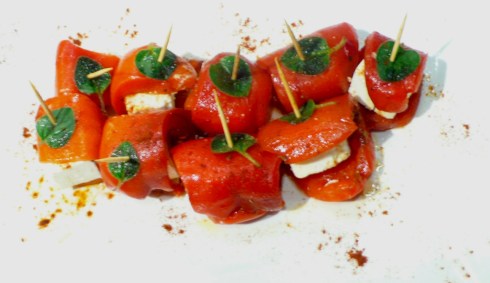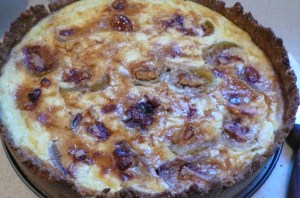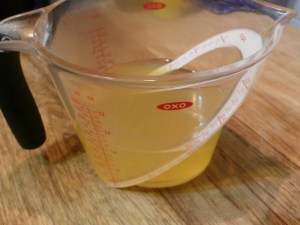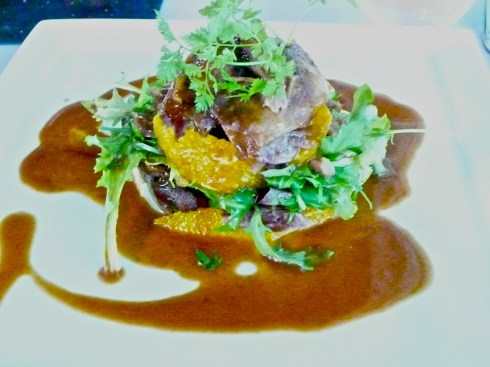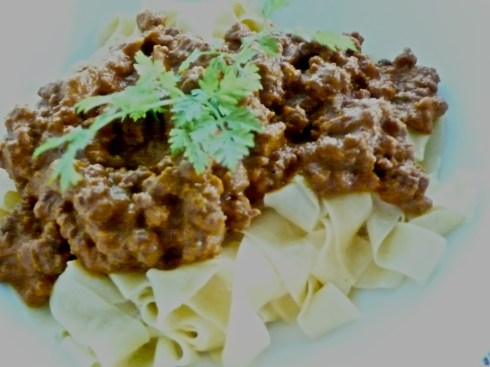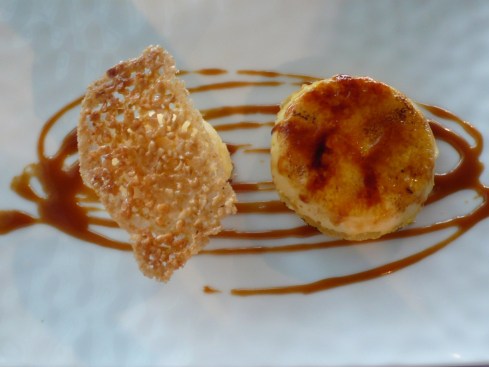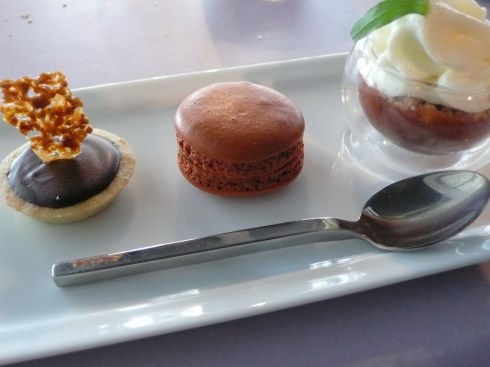 This is a complex, work intensive dish, but the results are nothing short of spectacular, if I might say so myself. The rich buttery puff pastry holds a wonderful creamy base laden with succulent deeply wine-y caramelised onions. Topped with melted raclette, the tart is complicated, delicious and very satisfying. These were created as a tapas for the O’Gourmet Food Hall Spanish red wine tasting, and were paired with a beautiful, organic Crianza 2005.
This is a complex, work intensive dish, but the results are nothing short of spectacular, if I might say so myself. The rich buttery puff pastry holds a wonderful creamy base laden with succulent deeply wine-y caramelised onions. Topped with melted raclette, the tart is complicated, delicious and very satisfying. These were created as a tapas for the O’Gourmet Food Hall Spanish red wine tasting, and were paired with a beautiful, organic Crianza 2005.
The onions were caramelised in an entire bottle of Crianza 2005, and cooked down into a thick jammy muddle for four hours. The puff pastry is simple, if you an find an all butter prepared puff pastry. If you cant, there are some amazingly easy recipes for foolproof puff pastry made with your food processor available online. Dont, under any circumstances, use puff pastry that is made with vegetable fat – it ruins everything!
Part of the problem with tarts of this kind is that even though the top bakes up gorgeously, the bottom is often underbaked. I solved this problem by baking the tarts as per normal, letting them cool for a few minutes, taking them out of their muffin tins, and flipping them over onto a baking sheet. I then baked them again in a very hot oven for about ten minutes, until the bottoms were golden and crisp, and just as delicious as the tops! We must always have balance in cooking…as in life.
I used raclette in this tart – a smooth very creamy melting cheese, often added to fondues. The cheese is rich and salty, yet mild. It compliments the onions, without overwhelming them. Baked into the tart the raclette melds with the onions and savoury custard into a molten cheesy joy.
You can serve this tart warm from the oven, or at room temperature within 24 hours. The recipe for the onions makes more than you need. Any extra can be used as the base for a magnificent pasta, a grilled cheese sandwich, or to spark your cooking imagination!
Makes 20 medium sized tarts. Do adjust for your own crowd!
Caramelised Red Wine Onions
- 1 cup (2 sticks – 16 tbsp) butter
- 8 cups (approximately 8 – 10 medium) yellow onions, sliced in fine half rings
- 1 bottle red wine (I used QV Crianza 2005)
- 1/4 cup red wine vinegar
- 1/4 cup balsamic vinegar
- 1/2 cup light brown sugar (organic if possible)
- Pepper and salt
In a large, heavy pan, over medium low heat, melt the butter. While the butter is slowly melting, prepare the onions. Peel, cut in half (from stem to root), and slice thinly. I always keep root intact to hold the onion together while I slice it.
Once the butter has melted, add the onions, and toss so that they are covered completely by the butter. Add about half a bottle of wine, the red wine vinegar, balsamic, sugar and a lot of pepper and a bit of salt. Stir well to combine, and cover the pan with a tight fitting lid. Reduce the heat a tad, and allow the mixture to simmer, stirring every ten minutes or so for about an hour.
By the end of an hour or so, the onions should be stained dark red with the wine, and quite soft. Remove the lid, add the remaining wine, stir well, and allow to cook down for another three hours or so, stirring every half an hour to make sure the onions dont burn. You can judge when you feel they are ready, but do try and give them as much time as possible. They will turn a deep dark wine red.
When the onions are ready, take off heat, and allow to cool to room temperature. Taste and adjust for salt and pepper.
These may be kept, covered, in the fridge, for up to 3 weeks.
Assembly
- 5 to 6 sheets all butter puff pastry (enough for 20 squares to fit muffin tins)
- Caramelised onions
- 4 eggs
- 2 cups cream
- Salt and pepper
- 300 gm raclette or other melting cheese, sliced thinly
Preheat the oven to 180C (350F). Spray a muffin tin pan with non stick spray (I used an organic canola oil). Line a large baking sheet with parchment or baking paper.
The puff pastry should be quite cold, yet malleable. If you have made fresh puff pastry, make sure you pop it in the freezer for about 5 minutes before cutting it. Cut the puff pastry into squares larger than the width of the muffin tin and place one square in each. I like the squares with the edges rough and untamed. I tend to like these tarts look rustic, but if you prefer an ordered tart, by all means cut big rounds.
Pierce the pastry with a fork all over (particularly the bottom), and bake in the oven for about 10 – 15 minutes until light golden.
Meanwhile, whisk together the eggs and cream, season with a bit of salt and pepper, and place in a pouring jug.
Once the pastry has been baked to golden brown, remove from the oven and let cool for a few minutes.
Place a tablespoon or more of the caramelised onions in each tart, and pour over the custard mixture. Bake again in the oven for about 1o minutes, and then remove and top the tarts with the sliced raclette or other melting cheese. Bake again for a further five minutes or so, or until the cheese has melted and is starting to bubble, and the custard is just set.
Remove the tarts from the oven and allow to cool for about 10 – 15 minutes. Remove from the muffin tins, and place onto the prepared baking pan upside down. Bake in the hot oven for a further 5 – 10 minutes, or until the bottoms are crispy and browned.
Allow to cool for at least 10 minutes before serving, or serve at room temperature within 1 day.
Enjoy!


